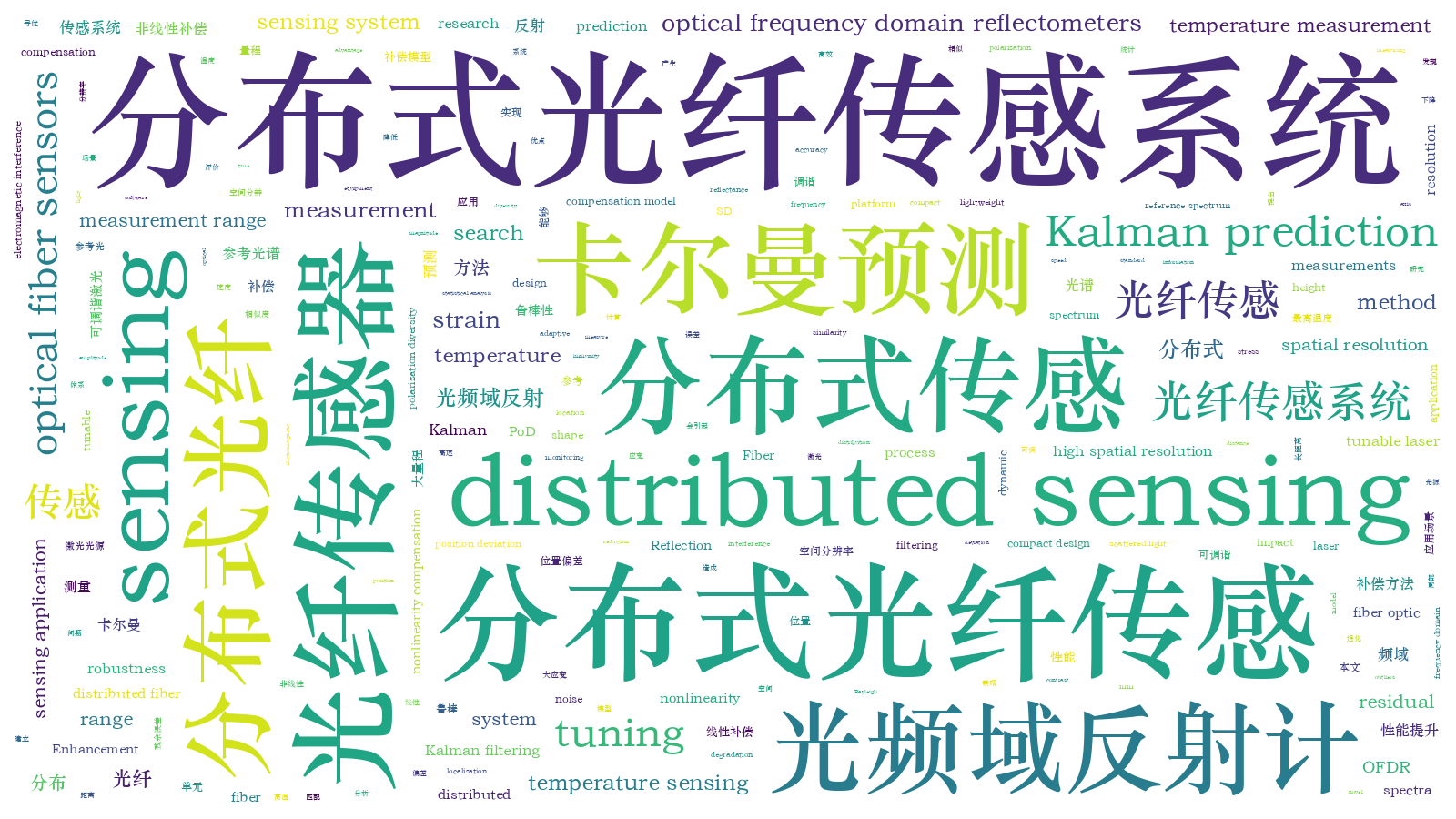基于卡尔曼预测的光频域反射分布式光纤传感性能提升方法  下载: 521次亮点文章特邀研究论文
下载: 521次亮点文章特邀研究论文
Distributed fiber optic sensing technology based on optical frequency domain reflectance (OFDR) has found extensive application in areas such as monitoring the health of structures and measuring temperature/strain in harsh environments. It has proven advantageous due to its ability to provide high spatial resolution, compact design, lightweight nature, and excellent immunity to electromagnetic interference. However, since the backward Rayleigh scattered light used for localization in OFDR is usually weak, the reduction in similarity (SD) between the reference spectrum and the measurement spectrum due to noise can significantly impact the robustness and accuracy of the system's measurements, especially in situations involving long distances, high temperatures, or a significant number of range strains. To address this problem, in this paper, we develop a tuning nonlinearity compensation model for tunable laser sources, finding that the residual tuning nonlinearity may lead to a random position deviation (PoD) for each sensing gauge. Based on the PoD statistical analysis, we build a system for evaluating the SD between the reference and measurement spectra. Combining with Kalman prediction and local search, the proposed method can match the reference and measurement spectra efficiently and accurately, resulting in compensation for the random PoD introduced in the sensing gauge of interest. We hope to extend the sensing range while realizing increased spatial resolution, robustness, and speed.
The research on tuning nonlinearity starts from the schematic diagram of a polarization diversity OFDR system. By examining the origins of its residual tuning nonlinearities, we employ statistical techniques to explore how they impact the PoD in each sensing gauge. The analyses illustrate that the innate noise from the tunable laser, similar to the outer strain or temperature variations, could contribute to the PoD. In particular, because of the statistical portrayal of the residual tuning nonlinearities, the additionally generated PoDs exhibit an approximately standard distribution. Based on this finding, we further design a process based on Kalman filtering (KF) and local search to compensate for the random PoDs from tuning nonlinearities, wherein two judgment conditions (JC1 and JC2) determine whether to enter/break the local search loop. Compared with other post-filtering methods, this method updates the measurement information by satisfying JC1 < TJC1 or minimizing JC2. This procedure is closer to real sensing scenarios and therefore improves the SD. Besides, we start the local search loop from the center (j = ±1) with higher probabilities to the distal (j = ±M) and break the loop once JC1 < TJC1. Thus, the presented strategy could accelerate the search process.
We compare the distributed sensing results recovered by the proposed method with the existing methods (Fig. 5). It is evident that the currently available approaches have limitations in terms of measurement length and strain/temperature measurement range due to the residual tuning nonlinearities. In contrast, the presented method can recover the strain/temperature distributed along the fiber axis without observing outliers, suggesting it can sufficiently compensate for the innate SD degradation due to the residual tuning nonlinearities. In particular, the robustness of the proposed method has a significant advantage when the measured strain or temperature is beyond 5000 με or 300 ℃, respectively. Additional examinations of the PoD random variations caused by the tuning nonlinearities and external stress indicate that the amplitude and range of the former are weaker (Fig. 7), implying that it is typically confined and temporary. The requirement to implement the adaptive judgment conditions JC1 and JC2 is verified in parallel. The distributed fiber optic strain/temperature sensing equipment and its software can achieve a sensing distance of greater than 150 m and a spatial resolution of 5 mm (Fig. 9), and the completion time of a single measurement under the full sensing range and the highest spatial resolution is less than 6 s. The system could measure strains varying from 2000 to 10000 με at about 140 m. A lateral comparison of each curve reveals that the shape of the data sets is similar, and the height of the "platform" is directly proportional to the applied strain. It is evident that the system effectively measures the magnitude and location of the sensing event; a horizontal comparison of the data sets demonstrates that the shape of the data sets is comparable, and the height of the "high platform" is linearly correlated to the applied strain.
In conclusion, the random PoD due to the residual tuning nonlinearities is theoretically verified to decrease the SD between the reference and measurement spectra in OFDR systems. A novel local search and dynamic prediction method based on KF is then proposed. This method can effectively compensate for the random PoD by local search and accelerate the search process by the KF prediction. Experiments show that the proposed method can significantly improve the robustness of the sensing system under the limited range (temperature of 450 ℃ and strain of 10000 με) sensing application. Moreover, it can compress the computation to 5.8%-28.6% of that without dynamic prediction operations.
党竑, 马彬, 高超, 祖文龙, 程琳淇, 陈金娜, 刘奂奂, 冯昆鹏, 张旭苹, 沈平. 基于卡尔曼预测的光频域反射分布式光纤传感性能提升方法[J]. 光学学报, 2024, 44(1): 0106016. Hong Dang, Bin Ma, Chao Gao, Wenlong Zu, Linqi Cheng, Jinna Chen, Huanhuan Liu, Kunpeng Feng, Xuping Zhang, Ping Shen. Performance Enhancement Method of Optical Frequency Domain Reflection Distributed Fiber Sensing Based on Kalman Prediction[J]. Acta Optica Sinica, 2024, 44(1): 0106016.







